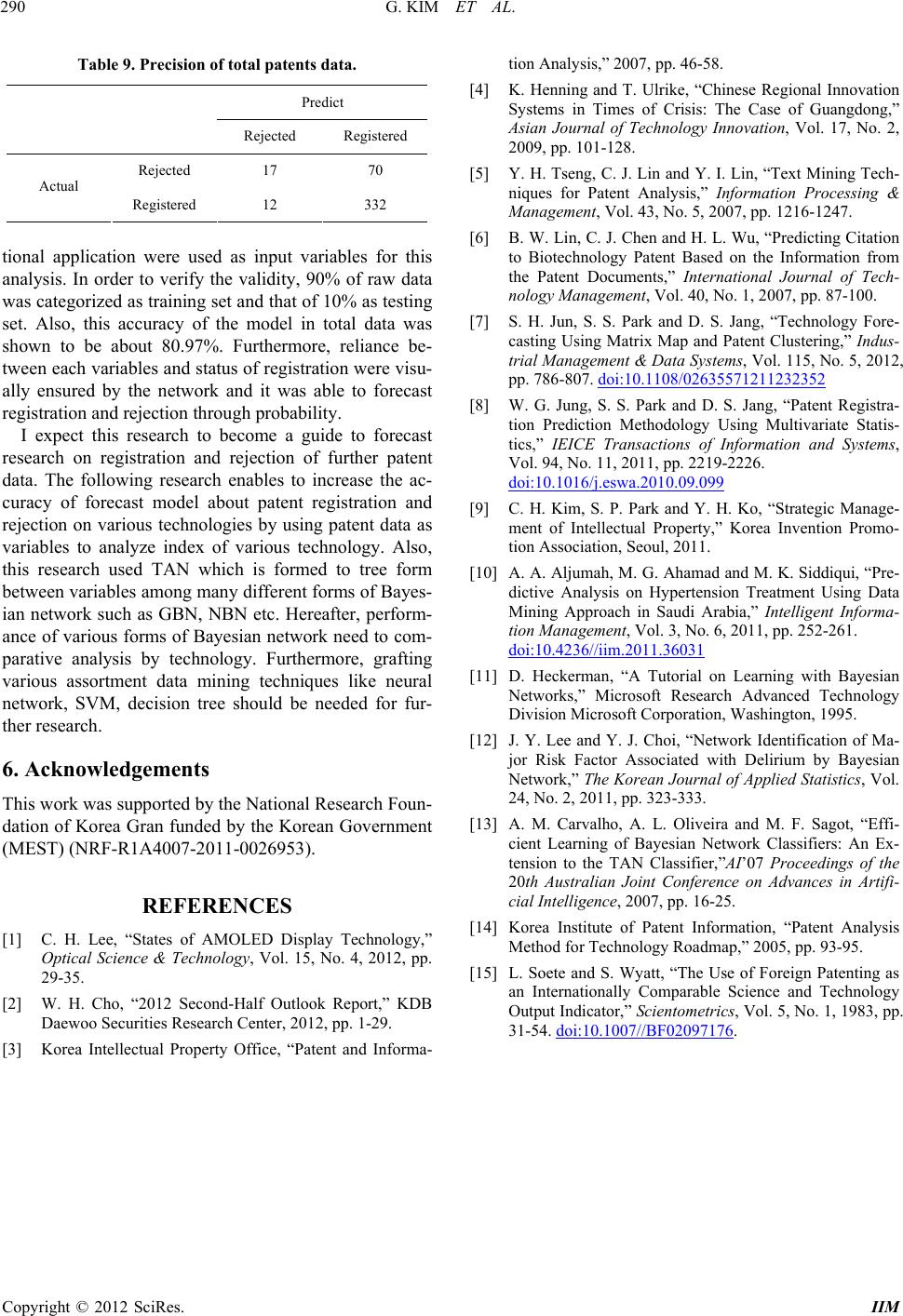
G. KIM ET AL.
Copyright © 2012 SciRes. IIM
290
Table 9. Precision of total patents data.
Predict
Rejected Registered
Rejected 17 70
Actual
Registered 12 332
tional application were used as input variables for this
analysis. In order to verify the validity, 90% of raw data
was categorized as training set and that of 10% as testing
set. Also, this accuracy of the model in total data was
shown to be about 80.97%. Furthermore, reliance be-
tween each variables and status of registration were visu-
ally ensured by the network and it was able to forecast
registration and rejection through probability.
I expect this research to become a guide to forecast
research on registration and rejection of further patent
data. The following research enables to increase the ac-
curacy of forecast model about patent registration and
rejection on various technologies by using patent data as
variables to analyze index of various technology. Also,
this research used TAN which is formed to tree form
between variables among many different forms of Bayes-
ian network such as GBN, NBN etc. Hereafter, perform-
ance of various forms of Bayesian network need to com-
parative analysis by technology. Furthermore, grafting
various assortment data mining techniques like neural
network, SVM, decision tree should be needed for fur-
ther research.
6. Acknowledgements
This work was supported by the National Research Foun-
dation of Korea Gran funded by the Korean Government
(MEST) (NRF-R1A4007-2011-0026953).
REFERENCES
[1] C. H. Lee, “States of AMOLED Display Technology,”
Optical Science & Technology, Vol. 15, No. 4, 2012, pp.
29-35.
[2] W. H. Cho, “2012 Second-Half Outlook Report,” KDB
Daewoo Securities Research Center, 2012, pp. 1-29.
[3] Korea Intellectual Property Office, “Patent and Informa-
tion Analysis,” 2007, pp. 46-58.
[4] K. Henning and T. Ulrike, “Chinese Regional Innovation
Systems in Times of Crisis: The Case of Guangdong,”
Asian Journal of Technology Innovation, Vol. 17, No. 2,
2009, pp. 101-128.
[5] Y. H. Tseng, C. J. Lin and Y. I. Lin, “Text Mining Tech-
niques for Patent Analysis,” Information Processing &
Management, Vol. 43, No. 5, 2007, pp. 1216-1247.
[6] B. W. Lin, C. J. Chen and H. L. Wu, “Predicting Citation
to Biotechnology Patent Based on the Information from
the Patent Documents,” International Journal of Tech-
nology Management, Vol. 40, No. 1, 2007, pp. 87-100.
[7] S. H. Jun, S. S. Park and D. S. Jang, “Technology Fore-
casting Using Matrix Map and Patent Clustering,” Indus-
trial Management & Data Systems, Vol. 115, No. 5, 2012,
pp. 786-807. doi:10.1108/02635571211232352
[8] W. G. Jung, S. S. Park and D. S. Jang, “Patent Registra-
tion Prediction Methodology Using Multivariate Statis-
tics,” IEICE Transactions of Information and Systems,
Vol. 94, No. 11, 2011, pp. 2219-2226.
doi:10.1016/j.eswa.2010.09.099
[9] C. H. Kim, S. P. Park and Y. H. Ko, “Strategic Manage-
ment of Intellectual Property,” Korea Invention Promo-
tion Association, Seoul, 2011.
[10] A. A. Aljumah, M. G. Ahamad and M. K. Siddiqui, “Pre-
dictive Analysis on Hypertension Treatment Using Data
Mining Approach in Saudi Arabia,” Intelligent Informa-
tion Management, Vol. 3, No. 6, 2011, pp. 252-261.
doi:10.4236//iim.2011.36031
[11] D. Heckerman, “A Tutorial on Learning with Bayesian
Networks,” Microsoft Research Advanced Technology
Division Microsoft Corporation, Washington, 1995.
[12] J. Y. Lee and Y. J. Choi, “Network Identification of Ma-
jor Risk Factor Associated with Delirium by Bayesian
Network,” The Korean Journal of Applied Statistics, Vol.
24, No. 2, 2011, pp. 323-333.
[13] A. M. Carvalho, A. L. Oliveira and M. F. Sagot, “Effi-
cient Learning of Bayesian Network Classifiers: An Ex-
tension to the TAN Classifier,”AI’07 Proceedings of the
20th Australian Joint Conference on Advances in Artifi-
cial Intelligence, 2007, pp. 16-25.
[14] Korea Institute of Patent Information, “Patent Analysis
Method for Technology Roadmap,” 2005, pp. 93-95.
[15] L. Soete and S. Wyatt, “The Use of Foreign Patenting as
an Internationally Comparable Science and Technology
Output Indicator,” Scientometrics, Vol. 5, No. 1, 1983, pp.
31-54. doi:10.1007//BF02097176.